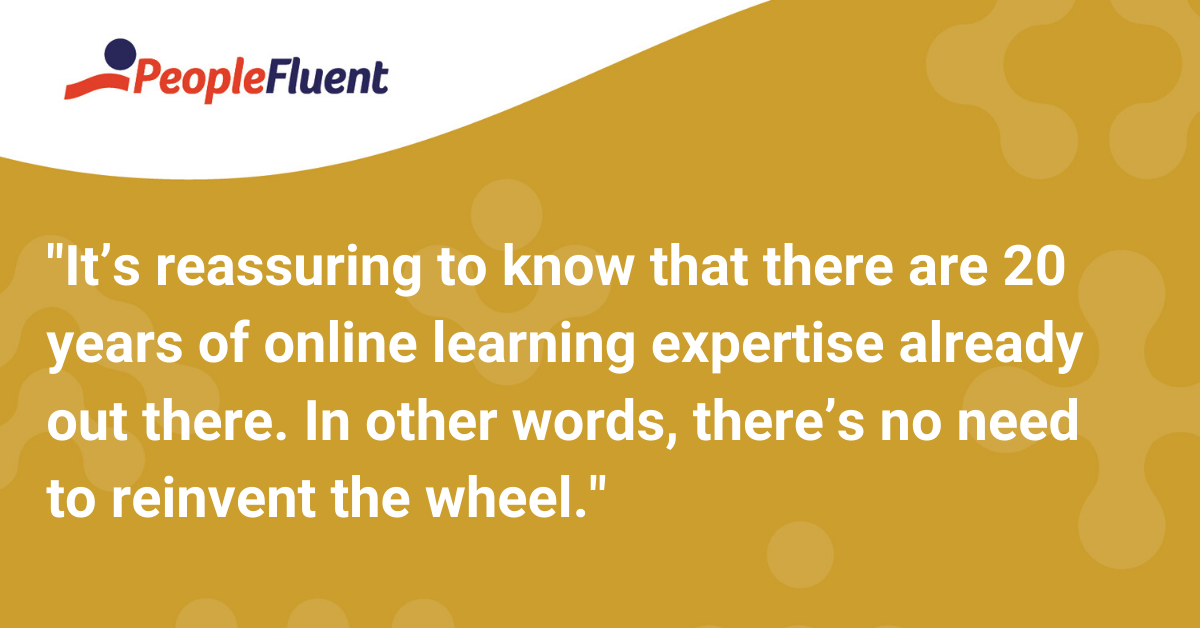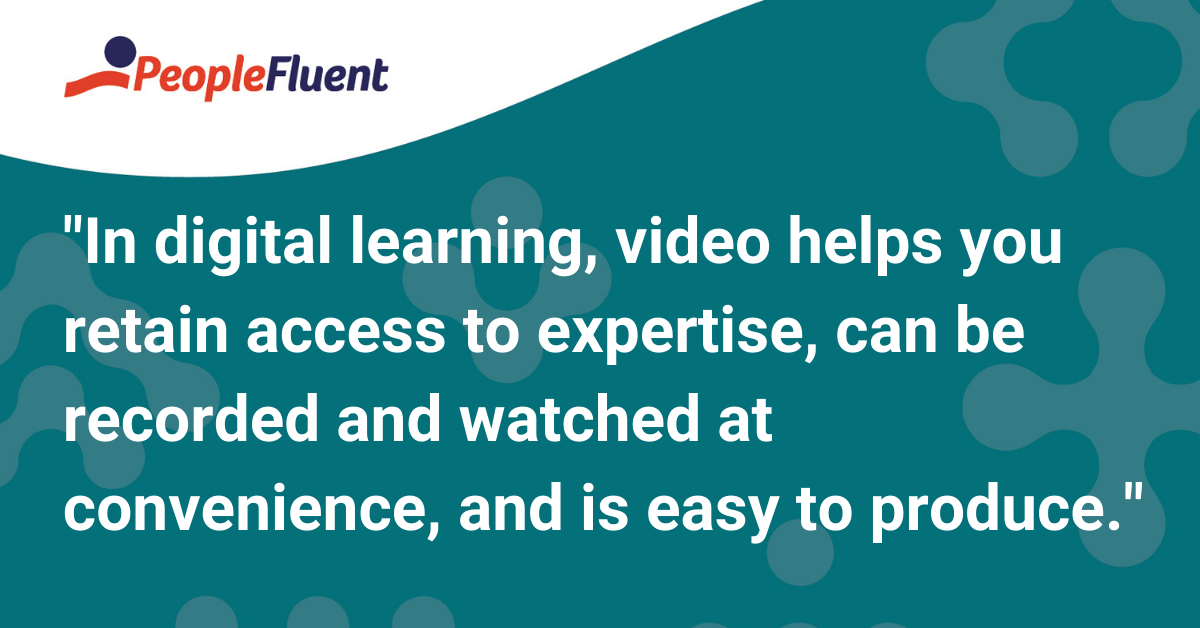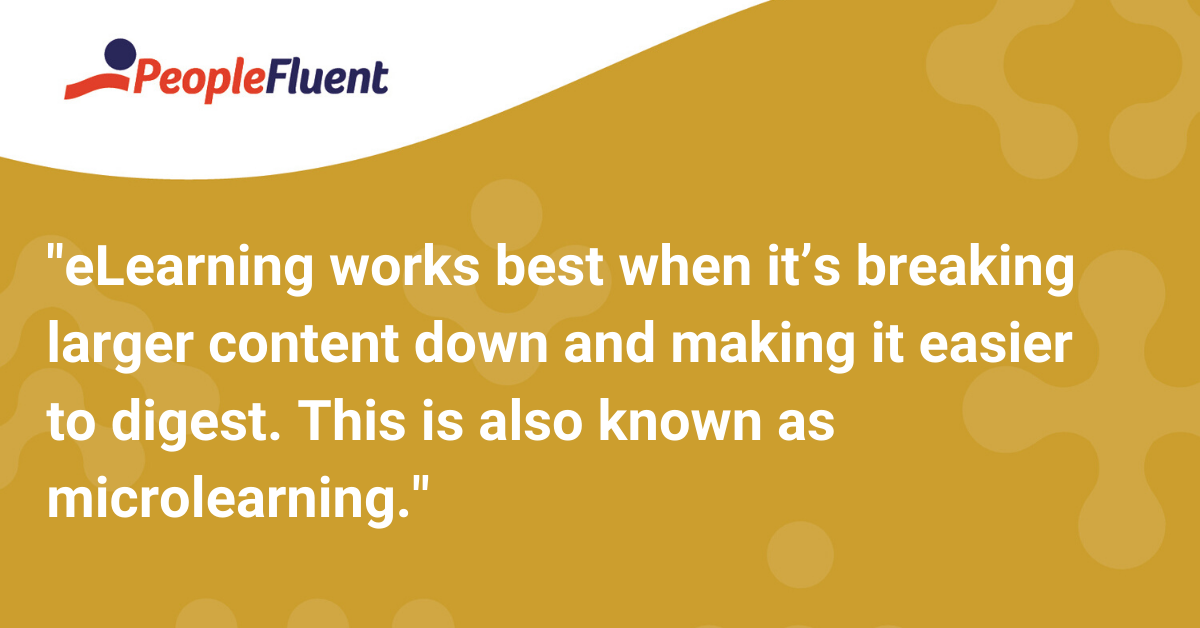Published: May 6, 2020Time to read: 8mins Category: Learning
3 Pillars of the Online Learning Blend That Will Save Your Training Plan
The time and effort you invested in planning face-to-face training needn’t go to waste. With the end of pandemic-related lockdowns uncertain, your classroom materials can be reappropriated with virtual classrooms, video and eLearning courses. Keep reading for a look at how online learning can best help you deliver great training.
Although most organizations were unprepared for the national lockdowns that the global progress of COVID-19 caused, much of the work employees created in the preceding weeks was done under the assumption of business as usual. For L&D professionals, this meant planning face-to-face training that may never happen. Our sister companies Gomo and LEO Learning recently held a webinar examining some ways in which such face-to-face training can be salvaged.
Recommended related reading: 'The 13 Must-Have Features of a Learning Management System'
Online Learning Isn’t a Wheel You Need to Reinvent
Why do we deliver training online? During an international lockdown, there isn’t really an alternative. Nonetheless, countless organizations have been choosing to deliver at least a portion of their training online for decades.
Online was traditionally chosen to cut out travel and other associated costs, and the need to wait until sufficient cohorts were available to train. However, as organizations experimented with eLearning formats, its versatility as a tool in its own right became apparent. For anyone who hasn’t looked deeply into online learning before now, it’s reassuring to know that there are 20 years of expertise already out there. In other words, there’s no need to reinvent the wheel.
Furthermore, the fundamental building blocks of online learning are no different to those of any other mode. You will need to have the following in mind:
- Business objective: What is your business goal in pursuing the current training?
- Performance outcome: What specific behavior do you want to change or improve?
- Learning objective: At the core of your learning solution, what thing do you want to teach?
While face-to-face learning allows you to adapt and respond to how your learners are receiving your content, being clearer on these targets is arguably even more important with online learning. With online learning, getting things right first time becomes essential.
More from the blog: ‘The Future of eLearning: Reclaiming Collaboration Through Digital Technology’

Three Pillars of the Online Learning Toolkit
We’re used to the idea of blended learning, meaning the use of online and face-to-face training formats. With true face-to-face training temporarily unavailable to us, it’s useful to acknowledge that a mixture of online learning approaches still constitutes an effective blend. The three pillars of online learning are virtual classrooms, video and eLearning, and knowing their strengths and weaknesses will allow you to create a better blended learning program.
1. Virtual Classrooms
The first thought for anyone with material already developed for face-to-face training will inevitably be: ‘Is it possible to take that material and deliver it virtually?’. Though virtual classrooms provide this in theory, in practice you will still need to modify your approach and your materials.
Virtual Classroom Benefits
- A practical alternative to bringing people together face to face that cuts down on the expense of travel.
- Can be easier to get busy subject matter experts into a session if they don’t have to travel.
- Learners can ask questions of someone they don’t usually have access to
- Can more easily fit into everyone’s schedule than face-to-face learning.
Virtual Classroom Drawbacks
- As with all online forms, you can’t expect learners to stay engaged for the same amount of time as you would with classroom learning.
- There are still expenses involved—SME/expert time and logistical costs.
- Virtual classrooms need more facilitators—having two or three voices helps reduce trainer and learner fatigue, allows you to head off technical problems and makes the training flow nicely.
Because of these drawbacks, we recommend rationing the use of virtual classroom sessions. Save them for the topics they’ll be most effective for, and avoid fatiguing your audience.
2. Video
Using video for training material is conceptually a simpler approach to what you would achieve with a virtual classroom. It simply removes all the advantages and potential issues of live training. The list of benefits and drawbacks reflect this:
Video Benefits
- Retains access to expertise.
- Time agnostic—the trainer can record at their convenience and the learner can watch whenever they have time to.
- Easy to produce—anyone can screen-capture and narrate a slide deck, or record a video chat. Note: These are all also major drawcards of a Learning Experience Platform.
Video Drawbacks
- Difficult to engage learners for any significant length of time. Beyond 30 minutes, your learners will likely stop absorbing information.
- Highly passive—no breaking to ask questions.
- Learners usually need more structure if they’re going to learn effectively.
As a mode of learning in its own right, video is dependable though, depending on your circumstances, it may always be optimal. We recommend using it when you can see no real benefit to holding a virtual classroom session (or when you can’t schedule one). Within the context of eLearning, video can also be quite powerful.
You might also like: ‘6 Reasons Why You Need to Start Using eLearning Video—Today!’

3. eLearning
eLearning is a broad term and encompasses the use of many different formats, including video. Depending on what eLearning authoring tool you use, you will be able to embed different media types, present that media in different layouts and use different question types such as multiple-choice, surveys, and drag and drop lists.
eLearning Benefits
- Primarily text-led and therefore quicker to consume than video alone.
- Wide range of formats help engagement.
- Interactive questions can give learning material a Q&A feel and help reinforce learning.
- Scope for self-service support e.g. glossaries, search and how-to pages.
- Easy to maintain and easy to adapt (e.g. the best authoring tools allow you to serve translated versions of your content).
- Backed up by assessment and reporting—SCORM and xAPI reporting standards can assist you in understanding how learning is being used.
eLearning Drawbacks
- As with all online formats, it’s difficult to be certain of engagement (though you can at least check for knowledge retention by including quizzes).
- Requires intensive planning to get the best results: you cannot respond back to the learner, so you have to pre-empt their questions.
Handpicked for you: ‘7 eLearning Tools Every L&D Pro Needs’
eLearning Dos and Don’ts
If you do choose the eLearning authoring route, that might be because eLearning can be used more liberally than virtual classrooms, and more effectively than a standalone video. Consider these quick do’s and don’ts for getting the most out of eLearning:
- Do make your eLearning look great (People are more forgiving of flaws in spoken content).
- Don’t overthink things—use accurate, clear language.
- Do use layouts consistently:
- Columns in a 50/50 or equal thirds arrangement will look best. Don’t tune column width just to make text fit.
- Don’t use a different layout for every course screen without reason. Instead, use two or three core layouts (otherwise, you risk making your work look unprofessional).
- Don’t be monotonous
- Make sure to use the interactive options available to you.
- Avoid using reams of text and occasional images.
- Do use friendly, conversational language.
- This helps learners take things on board.
- Remember, friendly can still be formal and authoritative.
- Don’t overload your learners
- If you want your learners to read an essay, there are better formats (e.g. a PDF.)...
- ...though longer formats will only work if people are going to be prepared to engage with them.
Ultimately, eLearning works best when it’s breaking larger content down and making it easier to digest. This is also known as microlearning. For example, though there’s a place for video in eLearning, it’s usually better to use smaller five-minute chunks rather than using a course as a container for a 30-minute video.
You might also like: ‘4 Tips for Organizations Using Technology to Train Staff Now Working From Home’

A version of this post originally appeared on the Gomo blog.
Want to get started with eLearning or video learning? Get in touch today to talk to one of our learning experts.
Discover How Learning Builds Skills and Ensures Compliance
Design, deploy, track, analyze, and report on enterprise learning and compliance programs. PeopleFluent helps you execute your programs seamlessly, so employees upgrade their skills and you get results.